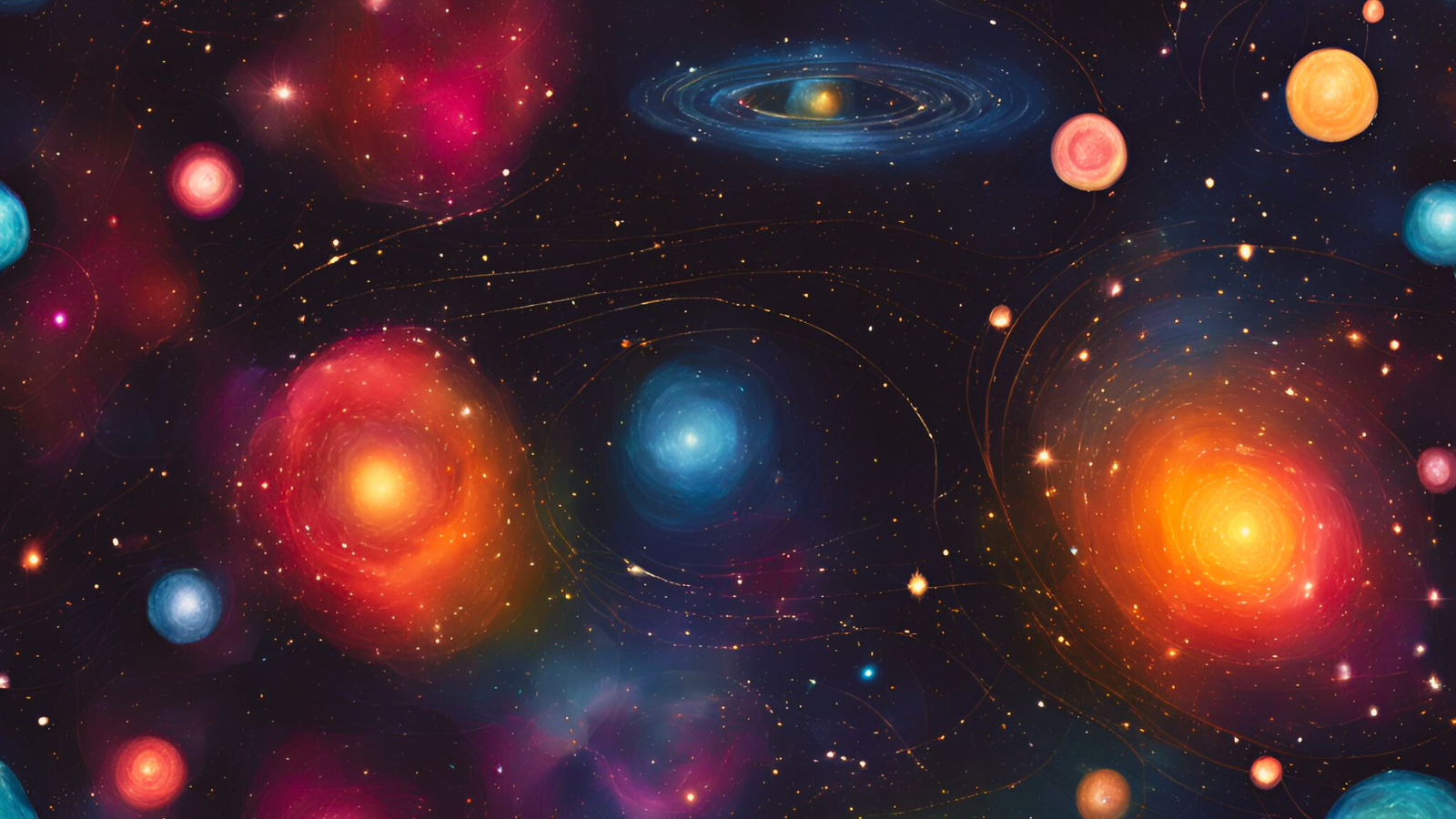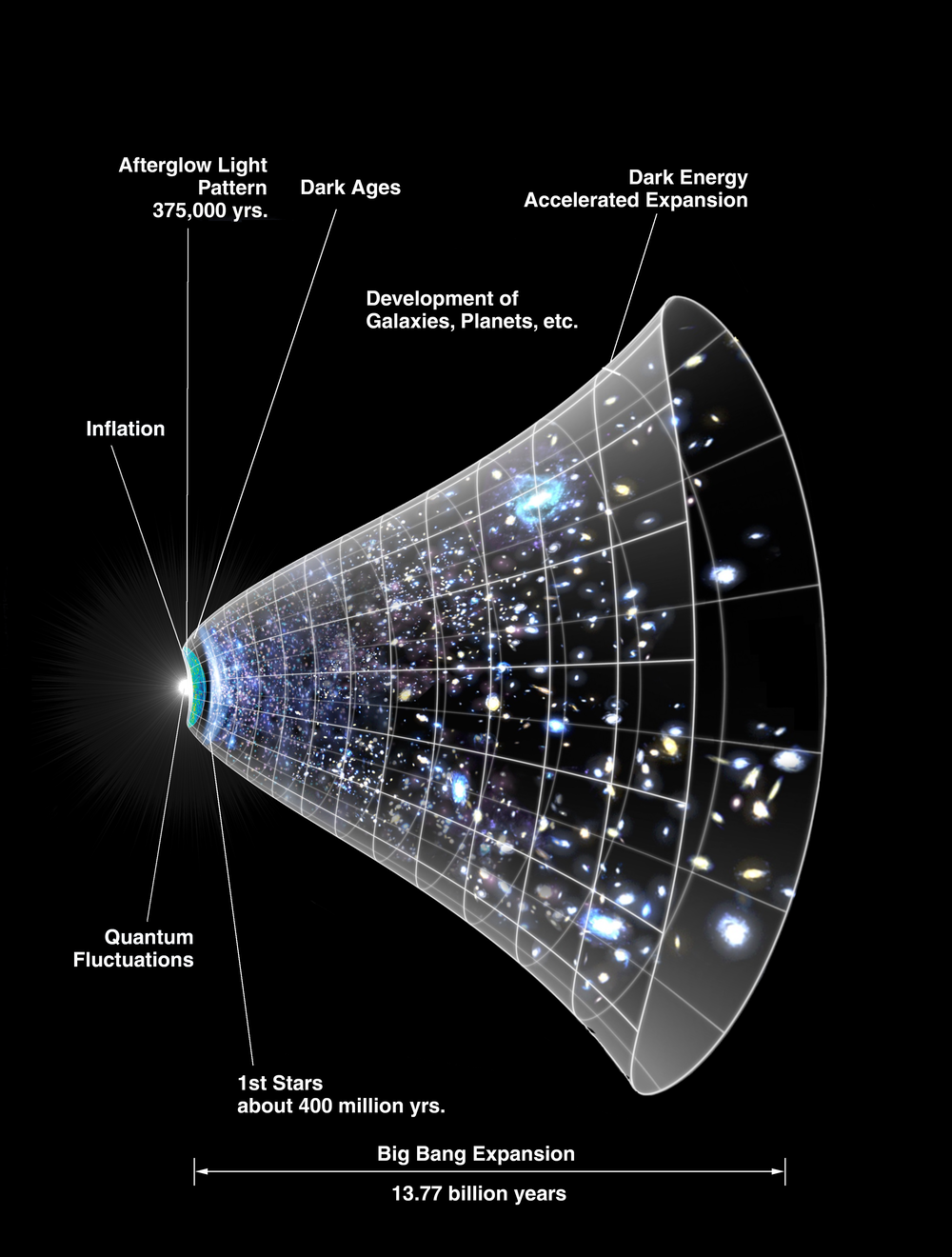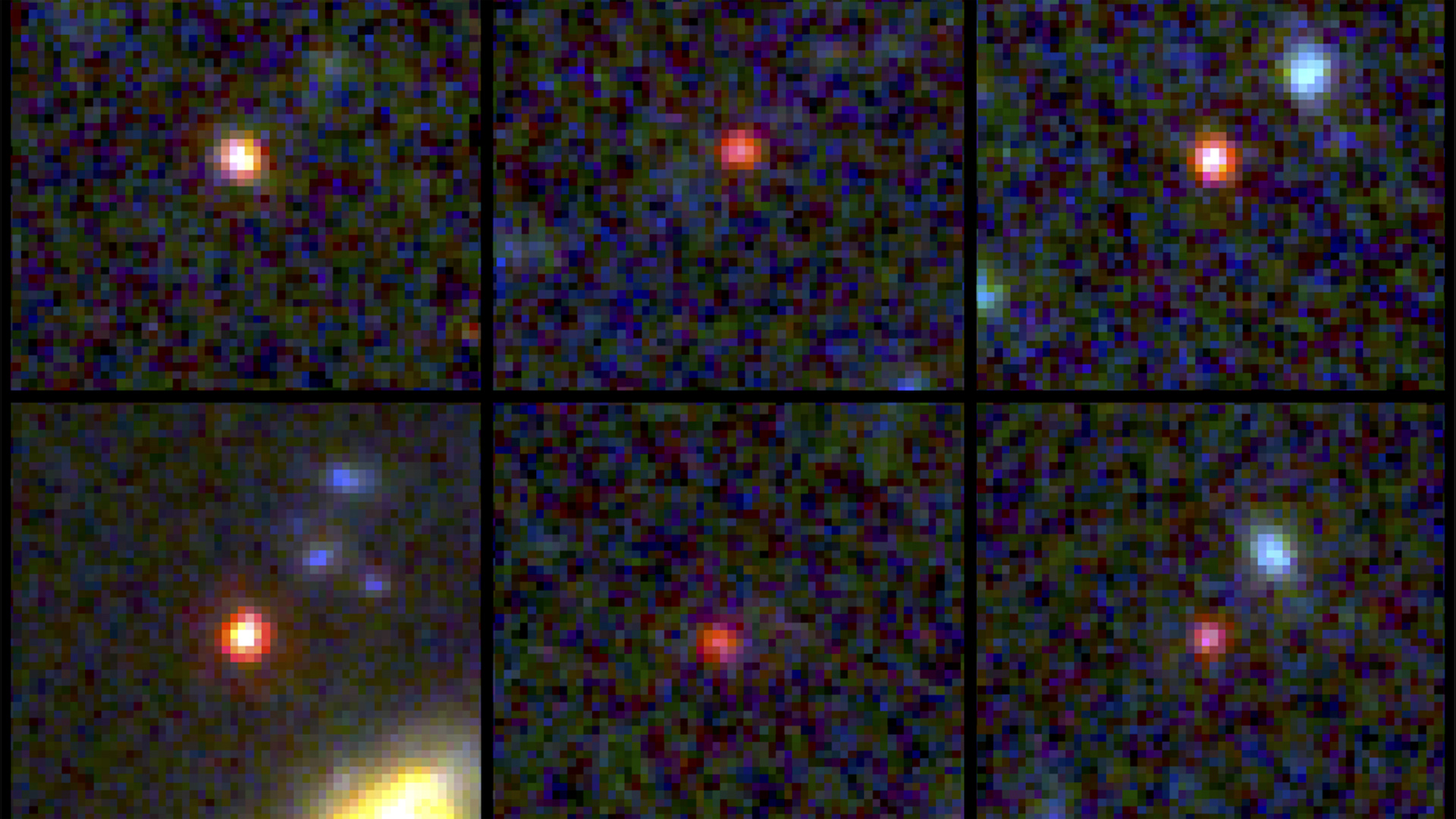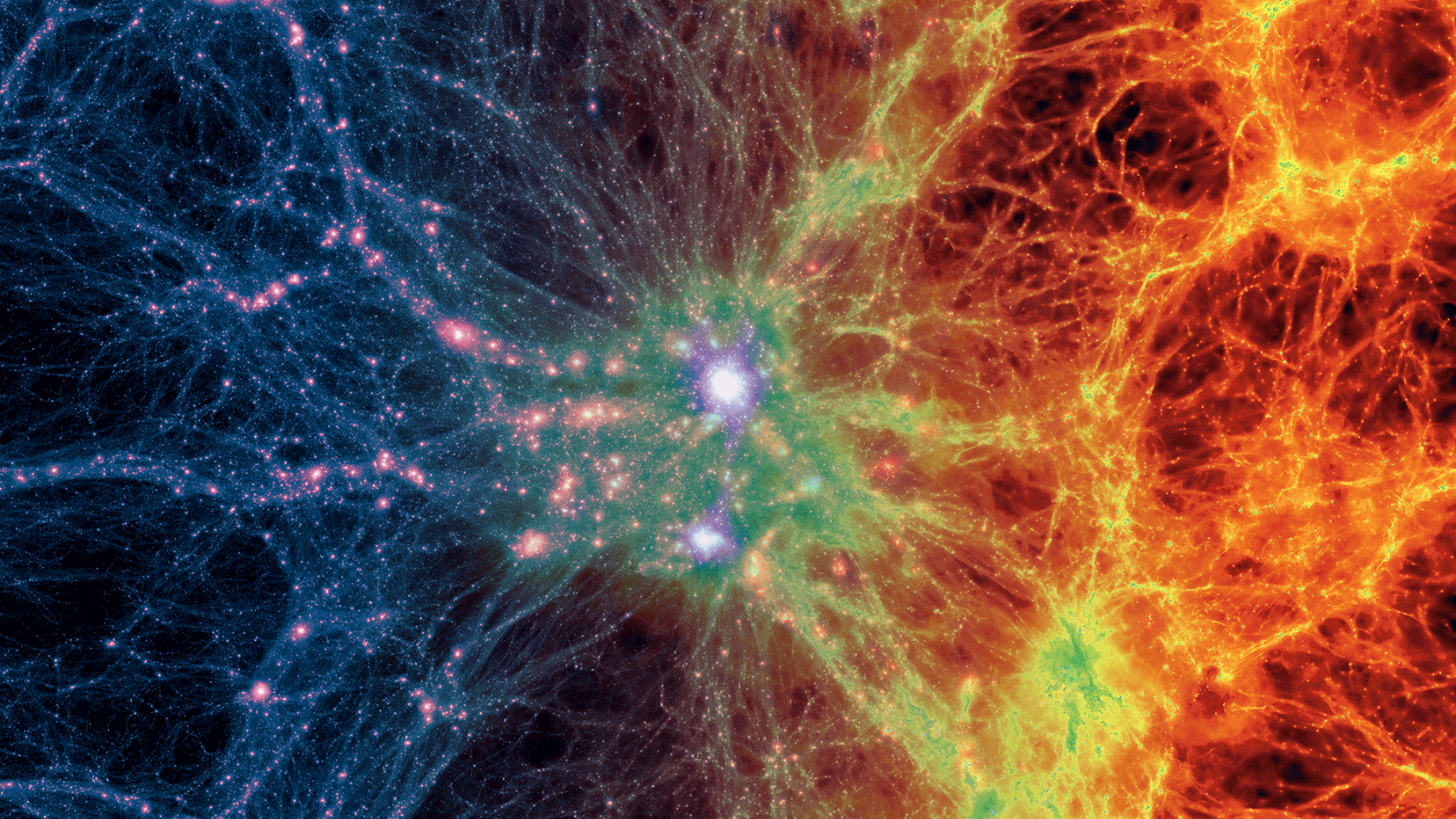How dark energy could relieve 'Hubble tension' and galaxy headaches
Too many bright early galaxies giving you a headache? Try new "early dark energy" for fast relief!

A new model that suggests dark energy — the mysterious force driving the acceleration of the universe's expansion — rose early in the cosmos could cure two of the most pressing astrophysical headaches.
One of these headaches is the "Hubble tension," which refers to a longstanding apparent disparity between the measured rate at which the universe is expanding. The other is the strange detection of bright galaxies in the early universe, during a time when scientists had thought the cosmos should be sparsely populated. The latter problem began to emerge after the James Webb Space Telescope (JWST) started making observations of the early and distant universe.
The new model is the brainchild of a team of scientists from the Massachusetts Institute of Technology (MIT) and the University of Texas at Austin. They think the key to these two puzzles is an extra ingredient in the cosmic pudding: early dark energy.
In principle, early dark energy should have been similar to the dark energy driving the expansion of the universe today. The difference, however, would be that, while modern dark energy began acting around 4 billion years ago, early dark energy would have appeared briefly in the early cosmos just thousands of years after the Big Bang. Then, it would have disappeared entirely.
Related: 'Hubble trouble' could deepen with new measurement of the universe's expansion
"You have these two looming open-ended puzzles," team member Rohan Naidu, a postdoctoral researcher at MIT's Kavli Institute for Astrophysics and Space Research, said in a statement. "We find that, in fact, early dark energy is a very elegant and sparse solution to two of the most pressing problems in cosmology."
Getting to work on the Hubble tension
The so-called Hubble tension arises from the fact that there are two primary ways of measuring the "Hubble constant," which is the rate at which the universe expands, and they don't agree.
Breaking space news, the latest updates on rocket launches, skywatching events and more!
One method looks at objects in the local universe like Type Ia supernovas, which astronomers call "standard candles" that can be used for cosmic distance measurements because their light output is so uniform. The other technique involves taking observations of the distant (and therefore early) universe, then calculating how fast the universe is expanding through deduction.
There is a hitch, though (isn't there always?). These methods deliver different values.
Early dark energy could resolve that, the team behind the new research believes. As an accelerating force activated just a few thousand years after the Big Bang, this substance could have acted against the force of gravity. That would mean a mismatch in values could arise from a failure to factor in early dark energy when calculating the Hubble constant from observations of the early universe.
"Early dark energy is one possible addition to the standard cosmological model that would preserve its many successes and resolve the Hubble tension," team member Michael Boylan-Kolchin, a professor of astronomy at The University of Texas at Austin, said in the statement.

What about that second problem that really began to manifest when the JWST found early galaxies almost as large as the Milky Way in the early universe?
Bright galaxies causing headaches? Try early dark energy!
This problem stems from the fact that it should have taken billions of years for hydrogen and helium gas to condense and form stars in volumes great enough to form large and bright galaxies like the Milky Way.
Yet, in 2023, the JWST spotted a shocking number of large and bright galaxies just 500 million years after the Big Bang, when the universe was only around 3% of its current age of 13.8 billion years.
"The bright galaxies that JWST saw would be like seeing a clustering of lights around big cities, whereas theory predicts something like the light around more rural settings like Yellowstone National Park," team leader Xuejian (Jacob) Shen, a Kavli postdoc at MIT said in the statement. "And we don’t expect that clustering of light so early on."

Rather than throw out all of our models of galactic evolution, however, the team suggests just adding early dark energy to the models.
Creating their own model of galaxy formation that took this into account, the team found the same early dark energy ingredient that seemed to relieve the Hubble tension also suggested the formation of large, bright galaxies in the kind of numbers the JWST is observing at present.
However, this did require the researchers to tamper with some of the universe's cosmological parameters and other celestial ingredients, like the volume of dark matter in the universe and the density of the cosmos shortly after the Big Bang.
It is unclear just how early dark energy could have led to the early formation of large galaxies in the infant universe — yet, the fact that this model could kill two cosmic birds with one stone means the team thinks it's worth pursuing.
"The fact that one model can explain these two unrelated issues makes it intriguing and worth pursuing in more detail," Boylan-Kolchin concluded. "By getting more data with JWST and studying the oldest light in the universe in more detail, we should actually know if early dark energy is the right answer within the next year or so, which is really exciting."
The team's research was published on Sept. 13 in the journal Monthly Notices of the Royal Astronomical Society.
Join our Space Forums to keep talking space on the latest missions, night sky and more! And if you have a news tip, correction or comment, let us know at: community@space.com.

Robert Lea is a science journalist in the U.K. whose articles have been published in Physics World, New Scientist, Astronomy Magazine, All About Space, Newsweek and ZME Science. He also writes about science communication for Elsevier and the European Journal of Physics. Rob holds a bachelor of science degree in physics and astronomy from the U.K.’s Open University. Follow him on Twitter @sciencef1rst.
-
Unclear Engineer This article is useless for explaining anything. But, it is a great example for how much the "standard" cosmological model simply invokes additional unexplained energy parameters to make it fit observations. At this point, there are really 3 different, unexplained, unconnected, "extra" energy concepts: the one that caused initial "inflation", the one that most recently causes accelerated expansion of the universe, and now this "early version" which supposedly:Reply
"In principle, early dark energy should have been similar to the dark energy driving the expansion of the universe today. The difference, however, would be that, while modern dark energy began acting around 4 billion years ago, early dark energy would have appeared briefly in the early cosmos just thousands of years after the Big Bang. Then, it would have disappeared entirely.
Nothing about why or how, so not an explanation.
And, further on, it states:
"It is unclear just how early dark energy could have led to the early formation of large galaxies in the infant universe — yet, the fact that this model could kill two cosmic birds with one stone means the team thinks it's worth pursuing."
So, they are already assuming that they can somehow find a way to claim that "early dark energy" can solve this problem, too, without even claiming to have done so , yet!!!
I guess that is a good assumption, considering that it is based on being able to imagine anything without having to explain it with physics that anybody actually understands.
But, to me, "explaining" an observation with an "explanation" that is simply putting another name on something that nobody understands is not an explanation at all. -
Helio Reply
Agreed. Besides, what's special at about 2k years after t=0? Almost any extra DE imagined could be assumed prior to Recombination (375k yrs. after t=0).Unclear Engineer said:"In principle, early dark energy should have been similar to the dark energy driving the expansion of the universe today. The difference, however, would be that, while modern dark energy began acting around 4 billion years ago, early dark energy would have appeared briefly in the early cosmos just thousands of years after the Big Bang. Then, it would have disappeared entirely.
Nothing about why or how, so not an explanation.
If they offer no physics to support their acceleration bump, it will appear ad hoc.
But not all "fixes" to BBT are ad hoc. The key is whether or not a fix produces a confluence with other lines of evidence. I don't see this fix doing this.
It's still unclear to me why DE in general doesn't explain the tension. Lemaitre's 1927 paper showed acceleration because he wouldn't dismiss the logic and elegance of Einstein's cosmological constant, though Einstein dumped it.
Ok. That would make it look a little more credible, I suppose.Unclear Engineer said:"It is unclear just how early dark energy could have led to the early formation of large galaxies in the infant universe — yet, the fact that this model could kill two cosmic birds with one stone means the team thinks it's worth pursuing."
Well, even I've been saying DE should solve it for quite a while. As I've stated in the past, "What good is acceleration if you never go faster?" Having the same Hubble-Lemaitre expansion rate for then and today would be far more problematic than the rates found.Unclear Engineer said:So, they are already assuming that they can somehow find a way to claim that "early dark energy" can solve this problem, too, without even claiming to have done so , yet!!!
Perhaps it's more a suppositional explanation.Unclear Engineer said:But, to me, "explaining" an observation with an "explanation" that is simply putting another name on something that nobody understands is not an explanation at all. -
Unclear Engineer Helio, you seem to have misinterpreted my comment about their just assuming that they will solve "the problem" with "early dark energy".Reply
I think we can agree that messing with dark energy assumptions can "explain" the apparent acceleration in the "Hubble tension".
But, the "problem" I was referring to that has not been solved, but is assumed to be solvable with "early dark energy", is the "early formation of large galaxies in the infant universe", The article explicitly says "It is unclear just how early dark energy could have led to the early formation of large galaxies in the infant universe - yet" and then goes on to say "the fact that this model could kill two cosmic birds with one stone means the team thinks it's worth pursuing."
So, it is only an assumption that this model can explain "the early formation of large galaxies in the infant universe".
But the title of this article is "How dark energy could relieve 'Hubble tension' and galaxy headaches" .
And it does not actually tell us "how". Or even claim that anybody has figured out "how". -
Helio Reply
IMO, DE does solve the tension but it's seems so obvious, that, as I said, the real tension would be if the expansion rates never changed. Given the likelihood that DE is a real phenomena, then why wouldn't there be a difference? Acceleration always increases velocity.Unclear Engineer said:Helio, you seem to have misinterpreted my comment about their just assuming that they will solve "the problem" with "early dark energy".
So, for me it is an obvious solution. But to put a bump in DE at 2k years seems very odd.
But to your point, they don't seem to present how their ideas would help form galaxies a little earlier than expected.
Right. I don't see why a little extra DE in the recipe is needed to cause quicker galaxy formation. It would seem to have more of an opposite effect.Unclear Engineer said:So, it is only an assumption that this model can explain "the early formation of large galaxies in the infant universe".
